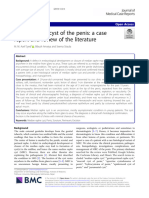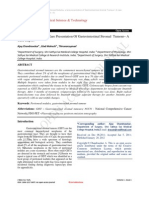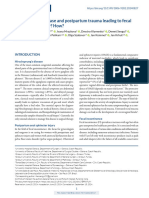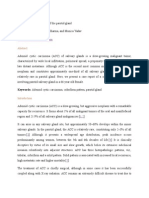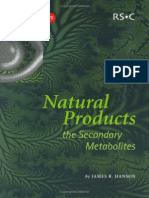Case Report: Submandibular Gland Mucocele: A Case Report and Literature Review
Case Report: Submandibular Gland Mucocele: A Case Report and Literature Review
Uploaded by
xxxCopyright:
Available Formats
Case Report: Submandibular Gland Mucocele: A Case Report and Literature Review
Case Report: Submandibular Gland Mucocele: A Case Report and Literature Review
Uploaded by
xxxOriginal Description:
Original Title
Copyright
Available Formats
Share this document
Did you find this document useful?
Is this content inappropriate?
Copyright:
Available Formats
Case Report: Submandibular Gland Mucocele: A Case Report and Literature Review
Case Report: Submandibular Gland Mucocele: A Case Report and Literature Review
Uploaded by
xxxCopyright:
Available Formats
Int J Clin Exp Med 2017;10(2):3868-3871
www.ijcem.com /ISSN:1940-5901/IJCEM0044758
Case Report
Submandibular gland mucocele:
a case report and literature review
Tzu-Hang Chi1,2, Rong-Feng Chen1, Chien-Han Yuan1, Shang-Tao Chien3
Departments of 1Otolaryngology, 3Pathology, Kaohsiung Armed Forces General Hospital, Kaohsiung, Taiwan,
Republic of China; 2Department of Otolaryngology, Taoyuan Armed Forces General Hospital, Taoyuan, Taiwan,
Republic of China
Received November 21, 2016; Accepted December 25, 2016; Epub February 15, 2017; Published February 28,
2017
Abstract: Mucoceles occur most commonly in the oral mucosa and minor salivary glands. The lower lip is the most
common site for the development of a mucocele, and occurrence in one of the major salivary glands is rare. A review
of literature written in English revealed 13 cases of submandibular gland mucocele. The etiology of mucoceles is
thought to involve partial obstruction or disruption of the salivary gland duct. Mucoceles are categorized as reten-
tion or extravasation mucoceles based on their histopathological appearance. Surgical removal is the preferable
treatment. Excision of a mucocele in continuity with the submandibular gland reduces the recurrence rate. A rare
case of a submandibular gland mucocele is reported.
Keywords: Mucocele, salivary gland, submandibular gland, retention, extravasation
Introduction right submandibular triangle of the neck (Fig-
ure 1). The neck mass was smooth and mo-
Mucoceles are common benign cystic lesions bile with no tenderness, and there was no ad-
that occur in the minor salivary glands. About ditional lymphadenopathy or palpable mass
60 to 70% of mucoceles occur in the lower lip, of the neck. The nose, ears, oral cavity, phar-
6 to 15% occur on the floor of the mouth, and ynx, and larynx were within normal limits in a
only a few cases have been reported to occur in series of examinations. The laboratory findings
the submandibular gland [1]. Factors such as showed a white blood cell count of 10.1×103/
trauma or obstruction of the salivary gland μL, neutrophil count of 75.5%, lymphocyte
ducts are thought to contribute to the develop- count of 14.0%, and C-reactive protein level of
ment of mucoceles [2]. Total excision of muco- 0.9 mg/dL. Computed tomography of the na-
celes reduces the recurrence rate. A case of a sopharynx to the neck with contrast showed
24-year-old man with a submandibular gland one 4.2×2.7-centimeter cystic-like, hypo-dense,
mucocele presenting as right-sided lateral neck and peripherally enhanced lesion involving the
swelling is reported. submandibular gland in the right submandi-
bular space (Figure 2). Fine needle aspiration
Case report
cytology of the cyst was performed, and the
The patient was a 24-year-old man with Down yellowish, serous, aspirated fluid was negative
syndrome. He was sent to the otolaryngology for malignancy. After physical, laboratory, radio-
outpatient department for treatment, and pain- logical, and cytological examinations, as well as
less swelling of the right lateral neck for one consideration of the patient’s history, a bran-
week was reported. There was no sore throat, chial cleft cyst was the tentative diagnosis.
toothache, dysphagia, otalgia, weight loss, or
fever. There was no family history of disease, Excisional surgery under general analgesia was
and there was no history of habitual cigarette performed. The incision was made about two
smoking or alcohol consumption. fingerbreadths below the jawline. The cystic-like
tumor closely adhered to the submandibular
The initial physical examination showed one gland, and no tract connecting the tumor to the
palpable 5.0×4.0-centimeter mass over the pharynx or hyoid bone could be identified. The
Mucocele: a case report and literature review
Figure 1. One palpable 5.0×4.0 centimeter mass Figure 3. Macroscopic appearance of the specimen
over the right submandibular triangle of neck. shows the excised cyst (white arrow) and subman-
dibular gland (black arrow).
Figure 2. Computed tomography of the nasopharynx Figure 4. Histological examination of the cyst reveals
to the neck shows one hypo-dense lesion of about mucinous material covered by granulation tissue (he-
1.2×2.7 centimeters with peripheral enhancement matoxylin and eosin stain, ×40).
involving the submandibular gland in the right sub-
mandibular space.
glands. The occurrence of mucoceles in major
tumor was completely excised along with the salivary glands is uncommon, and mucoceles
submandibular gland (Figure 3). The operative in the submandibular gland are rare. Searching
procedure went smoothly with no immediate published literature written in English, we found
complications. On gross examination of the 13 cases of submandibular gland mucocele
specimen, the cyst had a thick wall with yellow- were reported since the first case published
ish serous fluid contents. Microscopic examina- by Surkin et al at 1985 (Table 1). This literature
tion revealed mucus covered with granulation review reveals uneven distribution between
tissue without a lining epithelium (Figure 4). genders that the incidence was higher in
males compared to females (11 males and 2
The patient then received timely follow-up in females). Moreover, submandibular gland mu-
the otolaryngology outpatient department for cocele occurred in patients ranged from 16
six months. The patient had no evidence of months to 39 years of age (mean age 20.7±
recurrence or additional problems. 11.4 years). The lesion was observed on the
right side in 8 patients, on the left side for 4
Discussion patients and 1 patient had bilateral lesions.
Mucoceles are benign, cystic-like lesions that Mucoceles are categorized as retention or
can present at various sites of the oral mucosa extravasation mucoceles based on their histo-
and most commonly develop in minor salivary pathological appearance. A retention mucocele
3869 Int J Clin Exp Med 2017;10(2):3868-3871
Mucocele: a case report and literature review
Table 1. Demographic characteristics of 13 published cases of submandibular gland mucocele
Duration of
No. Auther Gender Age Side Treatment* Follow-up
symptoms
1 Anastassov et al [1] Male 18 years 3 months Left Excision with SMG, SLG 16 months
2 Anastassov et al [1] Male 30 years 10 years Right Excision with SMG, SLG 12 months
3 Surkin et al [4] Male 39 years 6 weeks Right Excision with SMG No evidence of disease
4 Choi et al [6] Male 16 months Several days Bilateral Excision with SMG, SLG 24 months
5 Van der Goten et al [7] Male 7 years 3 weeks Right Excision with SMG Not available
6 Van der Goten et al [7] Female 18 years 8 weeks Left Excision with SMG, SLG Not available
7 Boneu-Bonet et al [9] Male 25 years 6 months Right Excision with SMG No evidence of disease
8 Hze-Khoong et al [10] Male 21 years 1 week Right Excision with SMG No evidence of disease
9 Okumura et al [11] Male 7 years 2 years Right Excision with SMG, SLG No evidence of disease
10 Ozturk et al [12] Female 11 years 6 months Right Excision with SMG, SLG 8 months
11 Ozturk et al [12] Male 38 years 8 years Left Excision with SMG, SLG 34 months
12 Stranc et al [13] Male 29 years 1 month Right Excision Recurrence
13 Cholankeril et al [14] Male 25 years 6 months Left Excision with SMG 6 months
*
SMG: submandibular gland; SLG: sublingual gland.
is a mucus-containing cyst with an epithelial Surgical intervention is the preferable treat-
wall covering, while an extravasation mucocele ment for a submandibular gland mucocele.
is also a mucus-containing cyst but is covered Currently, the surgical methods include marsu-
by granulation tissue without an epithelium [3]. pialization, cystectomy, injection of sclerosing
agents, incision and drainage, excision of the
The mechanism of development is thought to mucocele in continuity with the sublingual
be partial obstruction of the salivary gland duct gland, and/or the submandibular gland [1].
in the case of retention mucoceles or disrup- Compared to other surgical methods that main-
tion of the salivary gland duct in the case of tain the submandibular gland, excision of a
extravasation mucoceles [4]. Retention muco- mucocele in continuity with the submandibu-
celes are more common at advanced age, while lar gland has the advantage of a lower recur-
extravasation mucoceles are commonly found rence rate. If the submandibular gland muco-
among young people [5]. cele affecting or closely next to the sublingual
gland, it is recommended to excise the sublin-
The clinical symptoms of submandibular gland
gual gland as well [9].
mucoceles include a painless, slow-growing
mass in the submandibular region. They usually In summary, even though mucoceles are rare
present as a soft, well-circumscribed, mobile and benign lesions that occur in the subman-
masses [6]. The differential diagnosis of a sub- dibular gland, they should always be included
mandibular cystic-like mass includes congeni- in the differential diagnosis of submandibu-
tal lesions such as branchial cleft cysts, der- lar cystic-like masses. The clinical symptoms
moid cysts, cystic hygroma, and thyroglossal include a painless, slow-growing mass in the
duct cysts, as well as acquired lesions such as submandibular region. Surgical intervention
ranula, abscesses, and cystic degeneration of with excision of the mucocele in continuity
neoplasms [7]. with the submandibular gland is the preferr-
ed treatment.
Computed tomography or magnetic resonance
imaging examinations are important for deter- Disclosure of conflict of interest
mining the accurate location of the lesion and
for distinguishing between benign and malig- None.
nant lesions. In addition, fine needle aspiration
cytology is useful for diagnosing cervical mass- Address correspondence to: Dr. Shang-Tao Chien,
es. The sensitivity rate for such masses is Department of Pathology, Kaohsiung Armed Forces
about 90 to 100%, but the false negative rate General Hospital, 2, Chung Cheng 1st Road, Kao-
for cervical cysts is as high as 50% [8]. hsiung 802, Taiwan, Republic of China. Tel: +886-7-
3870 Int J Clin Exp Med 2017;10(2):3868-3871
Mucocele: a case report and literature review
7494965; Fax: +886-7-7495175; E-mail: tzuhang- [8] Gourin CG, Johnson JT. Incidence of unsus-
chi@gmail.com pected metastases in lateral cervical cysts.
Laryngoscope 2000; 110: 1637-1641.
References [9] Boneu-Bonet F, Vidal-Homs E, Maizcurrana-
Tornil A, González-Lagunas J. Submaxillary
[1] Anastassow GE, Haiavy J, Solodnik P, Lee H, gland mucocele: presentation of a case. Med
Lumerman H. Submandibular gland mucocele: Oral Patol Oral Cir Bucal 2005; 10: 180-184.
diagnosis and management. Oral Surg Oral [10] Hze-Khoong EP, Xu L, Shen S, Yin X, Wang L,
Med Oral Pathol Oral Radiol Endod 2000; 89: Zhang C. Submandibular gland mucocele as-
159-163. sociated with a mixed ranula. Oral Surg Oral
[2] Yamasoba T, Tayama N, Syoji M, Fukuta M. Med Oral Pathol Oral Radiol 2012; 113: e6-e9.
Clinicostatistical study of lower lip mucoceles. [11] Okumura K, Inui M, Nakase M, Nakamura S,
Head Neck 1990; 12: 316-320. Hiramoto K, Tagawa T. A case of submandibu-
[3] Baurmash HD. Mucoceles and ranulas. J Oral lar gland mucocel. J Clin Pediatr Dent 2007;
Maxillofac Surg 2003; 61: 369-378. 31: 207-209.
[4] Surkin M, Remsen K, Lawson W, Som P, Biller [12] Ozturk K, Yaman H, Arbag H, Koroglu D, Toy H.
HF. A mucocele of the submandibular gland. Submandibular gland mucocele: report of two
Arch Otolaryngol 1985; 111: 623-625. cases. Oral Surg Oral Med Oral Pathol Oral
[5] Nico MM, Park JH, Lourenco SV. Mucocele in Radiol Endod 2005; 100: 732-735.
pediatric patients: analysis of 36 children. [13] Stranc MF, Skoracki R. A complication of sub-
Pediatr Dermatol 2008; 25: 308-311. mandibular intubation in a panfacial fracture
[6] Choi HJ, Kim SG, Kim JD, Kim JH, Kim JH, Kim patient. J Craniomaxillofac Surg 2001; 29:
SM. A case of bilateral submandibular gland 174-176.
mucoceles in a 16-month-old child. Korean J [14] Cholankeril JV, Scioscia PA. Post-traumatic si-
Pediatr 2012; 55: 215-218. aloceles and mucoceles of the salivary glands.
[7] Van der Goten A, Hermans R, Smet MH, Baert Clin Imaging 1993; 17: 41-45.
AL. Submandibular gland mucocele of the ex-
travasation type. Report of two cases. Pediatr
Radiol 1995; 25: 366-368.
3871 Int J Clin Exp Med 2017;10(2):3868-3871
You might also like
- Adenoid Cystic Carcinoma of Hard Palate: A Case ReportDocument5 pagesAdenoid Cystic Carcinoma of Hard Palate: A Case ReportHemant GuptaNo ratings yet
- Artikel OccipitomentaDocument12 pagesArtikel OccipitomentaSharon NathaniaNo ratings yet
- Case Report: A Rare Case of Congenital Simple Cystic Ranula in A NeonateDocument4 pagesCase Report: A Rare Case of Congenital Simple Cystic Ranula in A NeonateElvita Srie WahyuniNo ratings yet
- Chist Canal TireoglosDocument7 pagesChist Canal TireoglosAurel OctavianNo ratings yet
- Duktus ThyroglosusDocument13 pagesDuktus ThyroglosusOscar BrooksNo ratings yet
- Gossypiboma Case ReportDocument4 pagesGossypiboma Case ReportsiuroNo ratings yet
- Median Raphe Cyst of The Penis: A Case Report and Review of The LiteratureDocument9 pagesMedian Raphe Cyst of The Penis: A Case Report and Review of The LiteratureYi-Ke ZengNo ratings yet
- Tonsil TumorDocument4 pagesTonsil TumorafrisiammyNo ratings yet
- Study of Histopathological Spectrum of GallbladderDocument7 pagesStudy of Histopathological Spectrum of GallbladderleartaNo ratings yet
- Clinical Manifestation and Treatment of Small Intestinal Lymphangioma A Single Center Analysis of 15 Cases.Document6 pagesClinical Manifestation and Treatment of Small Intestinal Lymphangioma A Single Center Analysis of 15 Cases.joseph.v.fantinNo ratings yet
- A Study On Surgical Management of Undescended TestDocument6 pagesA Study On Surgical Management of Undescended TestAhmed teroNo ratings yet
- Testicular AppendagesDocument4 pagesTesticular AppendagesJohn stamosNo ratings yet
- 60 TH Male Spermatic Cord HydroceleDocument2 pages60 TH Male Spermatic Cord HydroceleSofie HanafiahNo ratings yet
- Metastatic Intranasal Mastocytoma in A Dog CR - 892 - 30.JULDocument6 pagesMetastatic Intranasal Mastocytoma in A Dog CR - 892 - 30.JULEzequiel Davi Dos SantosNo ratings yet
- Infected Urachal Cyst in An Adult A Case Report and Review of The LiteratureDocument3 pagesInfected Urachal Cyst in An Adult A Case Report and Review of The LiteratureAhmad Ulil AlbabNo ratings yet
- Effects of Acupressure On Fatigue in Patients With CancerDocument1 pageEffects of Acupressure On Fatigue in Patients With Cancerqdnguyen.8390No ratings yet
- Peritoneal Nodules, A Rare Presentation of Gastrointestinal Stromal Tumour - A Case ReportDocument2 pagesPeritoneal Nodules, A Rare Presentation of Gastrointestinal Stromal Tumour - A Case ReporteditorjmstNo ratings yet
- Cap Polyposis in Children: Case Report and Literature ReviewDocument6 pagesCap Polyposis in Children: Case Report and Literature ReviewLuis ArrietaNo ratings yet
- Rare Small Bowel Carcinoid Tumor A Case ReportDocument5 pagesRare Small Bowel Carcinoid Tumor A Case ReportAthenaeum Scientific PublishersNo ratings yet
- Simultaneous Papillary Carcinoma in Thyroglossal Duct Cyst and ThyroidDocument5 pagesSimultaneous Papillary Carcinoma in Thyroglossal Duct Cyst and ThyroidOncologiaGonzalezBrenes Gonzalez BrenesNo ratings yet
- Jurnal PaDocument4 pagesJurnal PametaNo ratings yet
- Articulo 1Document7 pagesArticulo 1Mariuxi CastroNo ratings yet
- Referat Pleomorphic AdenomaDocument6 pagesReferat Pleomorphic AdenomaAsrie Sukawatie PutrieNo ratings yet
- An Unusual Cause of "Appendicular Pain" in A Young Girl: Mesenteric Cystic LymphangiomaDocument3 pagesAn Unusual Cause of "Appendicular Pain" in A Young Girl: Mesenteric Cystic LymphangiomaSherif Abou BakrNo ratings yet
- 3 Cases of Papillary Thyroid Carcinoma Within Thyroglossal Duct 1 Pediatric and 2 Adult PatientsDocument4 pages3 Cases of Papillary Thyroid Carcinoma Within Thyroglossal Duct 1 Pediatric and 2 Adult PatientsScivision PublishersNo ratings yet
- Pancreatic Tuberculosis A Computed Tomography Imaging Review of Thirteen CasesDocument7 pagesPancreatic Tuberculosis A Computed Tomography Imaging Review of Thirteen CasesHạnh HoàngNo ratings yet
- Giant Appendiceal Mucocele: Report of A Case and Brief ReviewDocument3 pagesGiant Appendiceal Mucocele: Report of A Case and Brief ReviewjulietNo ratings yet
- Amjcaserep 21 E920438Document5 pagesAmjcaserep 21 E920438afifahNo ratings yet
- ANGIOSARCOMA A Rare Cause of Pleural MalignancyDocument3 pagesANGIOSARCOMA A Rare Cause of Pleural MalignancyInternational Journal of Innovative Science and Research TechnologyNo ratings yet
- Gingival Epulis: Report of Two Cases.: Dr. Praful Choudhari, Dr. Praneeta KambleDocument5 pagesGingival Epulis: Report of Two Cases.: Dr. Praful Choudhari, Dr. Praneeta KambleAnandNo ratings yet
- MainDocument4 pagesMainAshley2993No ratings yet
- International Journal of Health Sciences and Research: Appendiceal Mucocele: A MasqueradeDocument4 pagesInternational Journal of Health Sciences and Research: Appendiceal Mucocele: A MasqueradeSus ArNo ratings yet
- Jcem 0458Document8 pagesJcem 0458abigailNo ratings yet
- Hirschprung's Disease and Postpartum Trauma Leading To Fecal Incontinence: Why? How?Document5 pagesHirschprung's Disease and Postpartum Trauma Leading To Fecal Incontinence: Why? How?flaviasturraNo ratings yet
- Thyroglossal Duct Cyst - More Than Just An Embryological RemnantDocument4 pagesThyroglossal Duct Cyst - More Than Just An Embryological RemnantkancutpaulkadotNo ratings yet
- Malignant Mesothelioma of The Tunica Vaginalis TesDocument7 pagesMalignant Mesothelioma of The Tunica Vaginalis TesgedeonNo ratings yet
- A Rare Case of Endometriosis in Turners SyndromeDocument3 pagesA Rare Case of Endometriosis in Turners SyndromeElison J PanggaloNo ratings yet
- Neuroendocrine Tumors Dr. WarsinggihDocument20 pagesNeuroendocrine Tumors Dr. WarsinggihAndi Eka Putra PerdanaNo ratings yet
- Nephroblastoma: Radiological and Pathological Diagnosis of A Case With Liver MetastasesDocument5 pagesNephroblastoma: Radiological and Pathological Diagnosis of A Case With Liver MetastasesfifahcantikNo ratings yet
- Ultrasonography: A Cost - Effective Modality For Diagnosis of Rib Tuberculosis - A Case ReportDocument3 pagesUltrasonography: A Cost - Effective Modality For Diagnosis of Rib Tuberculosis - A Case ReportAdvanced Research PublicationsNo ratings yet
- SJMCR 119 1711-1713Document3 pagesSJMCR 119 1711-1713Gedeon MotsaNo ratings yet
- Symptomatic Lymphangioma of The Adrenal Gland: A Case ReportDocument3 pagesSymptomatic Lymphangioma of The Adrenal Gland: A Case Reportjulio perezNo ratings yet
- Ovarian Cysts and Tumors in Infancy and Childhood: Riginal RticleDocument4 pagesOvarian Cysts and Tumors in Infancy and Childhood: Riginal RticleIwan Budianto HadiNo ratings yet
- ACMCR-v14-2282-1Document5 pagesACMCR-v14-2282-1Dr Sunita KumariNo ratings yet
- Pleural MesotheliomaDocument4 pagesPleural MesotheliomablawosusiNo ratings yet
- Tan 2009Document5 pagesTan 2009Abhishek Soham SatpathyNo ratings yet
- Niu 2019Document7 pagesNiu 2019Dazz MiitNo ratings yet
- Dec24 16 PDFDocument8 pagesDec24 16 PDFijasrjournalNo ratings yet
- Dematos 1997Document6 pagesDematos 1997Ali AmokraneNo ratings yet
- Cavernospongiosum Shunt in Management of Priapism: Is It A Reliable Method?Document7 pagesCavernospongiosum Shunt in Management of Priapism: Is It A Reliable Method?Ahmed EliwaNo ratings yet
- Diagnostic Accuracy Fine Needle Aspiration Cytology of Thyroid Gland LesionsDocument6 pagesDiagnostic Accuracy Fine Needle Aspiration Cytology of Thyroid Gland LesionsinventionjournalsNo ratings yet
- Cistita Glandulo Chistica - Caz ClinicDocument3 pagesCistita Glandulo Chistica - Caz ClinicBarbuta AlexandraNo ratings yet
- Additional Article Information: Keywords: Adenoid Cystic Carcinoma, Cribriform Pattern, Parotid GlandDocument7 pagesAdditional Article Information: Keywords: Adenoid Cystic Carcinoma, Cribriform Pattern, Parotid GlandRizal TabootiNo ratings yet
- A Case Report and Literature ReviewDocument10 pagesA Case Report and Literature ReviewDerri HafaNo ratings yet
- Risk of Appendicitis in Patients With Incidentally Discovered AppendicolithsDocument4 pagesRisk of Appendicitis in Patients With Incidentally Discovered Appendicolithssuyudi kimikoNo ratings yet
- Risk of Appendicitis in Patients With Incidentally Discovered AppendicolithsDocument4 pagesRisk of Appendicitis in Patients With Incidentally Discovered Appendicolithssuyudi kimikoNo ratings yet
- Retrorectal Cystic Hamartoma - A Rare Case ReportDocument4 pagesRetrorectal Cystic Hamartoma - A Rare Case ReportScivision PublishersNo ratings yet
- Cystic ThyroidDocument4 pagesCystic ThyroidabhishekbmcNo ratings yet
- Non-Traumatic Rupture of Spleen Can Splenectomy BeDocument3 pagesNon-Traumatic Rupture of Spleen Can Splenectomy Beysh_girlNo ratings yet
- Abdominal Tuberculosis: Diagnosis and Management in 2018: Journal, Indian Academy of Clinical Medicine March 2018Document5 pagesAbdominal Tuberculosis: Diagnosis and Management in 2018: Journal, Indian Academy of Clinical Medicine March 2018xxxNo ratings yet
- JIndianAcadOralMedRadiol28144-334794 091759Document4 pagesJIndianAcadOralMedRadiol28144-334794 091759xxxNo ratings yet
- Surgical Management of Mucocele by Using Diode Laser: Two Case ReportsDocument3 pagesSurgical Management of Mucocele by Using Diode Laser: Two Case ReportsxxxNo ratings yet
- 1 s2.0 S1607551X11000349Document4 pages1 s2.0 S1607551X11000349xxxNo ratings yet
- Case Reports: Annals and Essences of DentistryDocument3 pagesCase Reports: Annals and Essences of DentistryxxxNo ratings yet
- Salivary Mucoceles in Children and Adolescents A Clinicopathological StudyDocument5 pagesSalivary Mucoceles in Children and Adolescents A Clinicopathological StudyxxxNo ratings yet
- Oralmucocele AcasereportDocument5 pagesOralmucocele AcasereportxxxNo ratings yet
- Canon JudgeDocument69 pagesCanon JudgeHazel-mae LabradaNo ratings yet
- Ten-Day Report of Change For Medicaid/Hawki: Iowa Department of Human ServicesDocument6 pagesTen-Day Report of Change For Medicaid/Hawki: Iowa Department of Human ServicesNephNo ratings yet
- Pharmaceutical Calulations - PharmacistDocument92 pagesPharmaceutical Calulations - PharmacistFouziya BegumNo ratings yet
- F03-Competence MatrixDocument10 pagesF03-Competence MatrixSiva SuryaNo ratings yet
- Ethics Presentation 1Document12 pagesEthics Presentation 1api-587758532No ratings yet
- Process Considerations On The Application of High Pressure Treatment at Elevated Temperature Levels For Food PreservationDocument102 pagesProcess Considerations On The Application of High Pressure Treatment at Elevated Temperature Levels For Food PreservationWilliam Rolando Miranda ZamoraNo ratings yet
- 2783 Ais - Database.model - file.PertemuanFileContent James Ralph Hanson Natural Products The Secondary Metabolites (Tutorial Chemistry Texts) 2003Document149 pages2783 Ais - Database.model - file.PertemuanFileContent James Ralph Hanson Natural Products The Secondary Metabolites (Tutorial Chemistry Texts) 2003Dyah Indah Rini100% (4)
- Different Equipment Onboard Ships: Pollution PreventionDocument7 pagesDifferent Equipment Onboard Ships: Pollution PreventionIman SadeghiNo ratings yet
- Scoring Predictor For Successful of Arteriovenous Fistulas As Vascular Access in Hemodialysis Patients: PAVAS ScoreDocument6 pagesScoring Predictor For Successful of Arteriovenous Fistulas As Vascular Access in Hemodialysis Patients: PAVAS ScoreAnonymous ATdLPZNo ratings yet
- Taqpath Covid 19 Ce Ivd FaqDocument4 pagesTaqpath Covid 19 Ce Ivd Faqmiguel david MarfilNo ratings yet
- At2 Sitxwhs002Document12 pagesAt2 Sitxwhs002Manish GhimireNo ratings yet
- Pathophysiology of EmphysemaDocument3 pagesPathophysiology of EmphysemaApple Maiquez Garcia100% (1)
- Introduction To Pediatric VentilationDocument41 pagesIntroduction To Pediatric Ventilationedderj2585No ratings yet
- Case Study 11Document3 pagesCase Study 11api-347141638No ratings yet
- Twin StudiesDocument219 pagesTwin StudiesUniversity of Adelaide PressNo ratings yet
- Examples RWE Report - 0Document183 pagesExamples RWE Report - 0Kothapalli ChiranjeeviNo ratings yet
- Spooky Psychology (Working Title) Draft 2Document20 pagesSpooky Psychology (Working Title) Draft 2api-278063500No ratings yet
- Barangay Bantay Asin Task ForceDocument2 pagesBarangay Bantay Asin Task ForceJohn Lester Jawaad AsesorNo ratings yet
- Report-Snehalaya Home For Child RightsDocument16 pagesReport-Snehalaya Home For Child RightsNishan MedhiNo ratings yet
- 4) FAAS 608 - Week 6 7Document226 pages4) FAAS 608 - Week 6 7Online NinaNo ratings yet
- Đo N VănDocument3 pagesĐo N Vănkhue nNo ratings yet
- Santrock Section 4 Early ChildhoodDocument15 pagesSantrock Section 4 Early ChildhoodAssumpta Minette Burgos100% (1)
- Physician Directory - WorldDocument249 pagesPhysician Directory - Worldsonukarma321No ratings yet
- Affective Bipolar Disorder Episodes Kini ManiaDocument16 pagesAffective Bipolar Disorder Episodes Kini ManiaDeasy Arindi PutriNo ratings yet
- 1.2 Background of The StudyDocument1 page1.2 Background of The StudyHarold FilomenoNo ratings yet
- President Barak Obamas Makes Historic Speech To America's Students.Document4 pagesPresident Barak Obamas Makes Historic Speech To America's Students.Antonio PenaNo ratings yet
- 47 Best COVID-19 Coverage - Anniversary 1 - StaffDocument10 pages47 Best COVID-19 Coverage - Anniversary 1 - StaffSteve TaylorNo ratings yet
- Vic Leaner GuideDocument162 pagesVic Leaner GuideSachNo ratings yet
- Module 9 School AgeDocument16 pagesModule 9 School AgeMichelle FactoNo ratings yet
- Electronics Engineers 04-2024Document9 pagesElectronics Engineers 04-2024PRC BaguioNo ratings yet






